Nancy Buirski’s masterpiece is much more than a documentary on John Schlesinger’s Midnight Cowboy, screenplay by Waldo Salt, shot by Adam Holender, costumes by Ann Roth, and starring Jon Voight and Dustin Hoffman with Sylvia Miles, Brenda Vaccaro, Jennifer Salt, and Bob Balaban. Desperate Souls, Dark City And The Legend Of Midnight Cowboy, edited by Anthony Ripoli, features on-camera interviews shot by Rex Miller with Lucy Sante, Brian De Palma, Edmund White, Michael Childers, Charles Kaiser, Jim Hoberman, Ian Buruma, Voight, Vaccaro, Balaban, Holender, and Jennifer Salt.
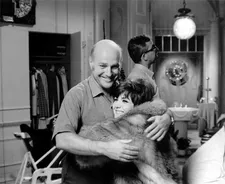 |
| Brenda Vaccaro with John Schlesinger: “Ann Roth saved my life,” says Vaccaro, “by putting me in that fur coat.” |
The evocative, wide-ranging, and evermore timely documentary drops us off at the start with Jon Voight telling the story of his encounter with John Schlesinger in full self doubt at the end of shooting Midnight Cowboy. “What have we done?” he remembers the director questioning. To calm him down, the actor called it a masterpiece “that will outlive us.” Voight in present time tears up. His soothing words turned out to be the truth. The film won three Oscars, for Best Film, Best Adapted Screenplay, Best Director, while Voight lost out to John Wayne for his performance in Henry Hathaway’s True Grit. “I see by your outfit that you are a cowboy” is a line from the The Streets Of Laredo, the song chosen over the end credits. Cowboys and outfits, kind words and life-saving deeds in a violent time make us reflect and associate in-between.
Voight’s screen test features him dressed in black hat and purple shirt, complete with red flower appliqués that resemble wounds, and a shy laugh. There is the voice of screenwriter Waldo Salt, and his daughter Jennifer commenting on-screen. Vietnam footage functions as a red thread for the era. A harmonica plays. The incredibly intricate combinations of visuals and sounds, the chosen songs and the speaking voices, the film clips and the order they appear in - all form a tapestry of meanings, an emotional homage and a call to awareness for the present moment.
Dustin Hoffman is heard saying that his role in Midnight Cowboy was no stretch for him, that indeed “Ratso was an interior feeling for me.” All he had to find was the walk. Hoffman went on to work again with Schlesinger in Marathon Man, starring opposite Laurence Olivier. Jennifer Salt, who played Crazy Annie in Midnight Cowboy, points out her father’s sweetness and generosity and believes that ultimately he was blacklisted because of this nature. “Anger turned into wisdom,” is one of the many sentences you can return to again and again.
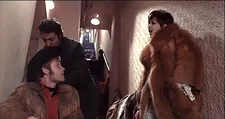 |
| Joe Buck (Jon Voight) and Ratso Rizzo (Dustin Hoffman) with Shirley (Brenda Vaccaro) in the fur coat |
A clip from William Wyler’s 1961 The Children’s Hour, in which Audrey Hepburn and Shirley MacLaine play lovers, follows a discussion of Stonewall and Buirski trusts the audience fully to connect our dots. The first gay kiss in cinema in Schlesinger’s Sunday, Bloody Sunday is juxtaposed with a Mike Wallace TV special at the time on homosexuality, that was, as author, critic, and journalist Charles Kaiser says “full of homophobic drivel.” Lucy Sante comments that “now that I’m a transsexual, I thought there was no place for me.” Andy Warhol and Flaming Creatures, the 1966 Oscar for The Sound Of Music, mainstream was about to change. Rosemary’s Baby about to be born.
From New York City, Nancy Buirski joined me on Zoom for an in-depth conversation on Desperate Souls, Dark City And The Legend Of Midnight Cowboy the day before the opening.
Anne-Katrin Titze: Good morning!
Nancy Buirski: Good morning, how are you?
AKT: I’m fine! Nancy, where are you?
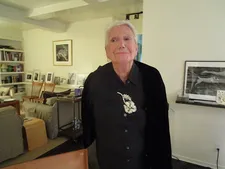 |
| Nancy Buirski on Midnight Cowboy costume designer Ann Roth: “I spoke with her and we had a wonderful long conversation …” Photo: Anne-Katrin Titze |
NB: In New York City and it’s raining out! I got the cap on, I just came in from the rain.
AKT: I was debating with myself just moments ago: shall I start with the perfect beginning of your film or with the perfect ending? I think I’ll start with the ending and The Streets Of Laredo. It stayed in my head for a long time after. It’s the perfect send-off song.
NB: Thank you so much for noticing that! So many of these things become part of the overall gestalt of the movie and one forgets. The Streets Of Laredo is such an iconic Western melody. It’s fascinating when you think about how we take so much of that for granted but that is the Western mythology that we’re dealing with. And it’s faded.
I mean Streets Of Laredo will last forever but in some way it’s faded just like the Western mythology has. That’s an important theme in our film. It’s nice that you mention it because it is a sweet way to kind of leave all this behind. Because what we’re doing is talking about something in the past, but also something that’s very present.
AKT: Very much so! And the Western mythology how it was used in Midnight Cowboy! You have constant references to Vietnam. I think it is Jim Hoberman who says that all these men going to Vietnam grew up on Westerns, which is something we forget. It is all encircling, really, this film Midnight Cowboy, which is such a strange beacon.
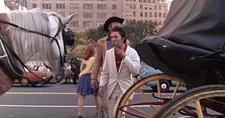 |
| Ratso Rizzo (Dustin Hoffman) in his non-matching white suit with Joe Buck (Jon Voight) |
NB: It’s true, I mean what we’re trying to do with our film is show how things that are in the air filter down and became an important touchstone for the people who were making that film. As Lucy Sante says, you never purposely make a film about the zeitgeist, but it’s there. It’s the oxygen you’re breathing.
AKT: She also says “Nobody really knows their own time.”
NB: Yes, that’s quite beautiful. I think the idea that people say, well, this is a movie of its time - how does this happen? If you’re going to Vietnam and you’ve grown up on Westerns, what does that say to you about the cowboy mentality? What does it say to you about indigenous people who were fighting in Vietnam? And the indigenous people that we fought here in the United States? It’s all connected.
AKT: This is what your film so brilliantly does! I also thought about James Baldwin writing about Westerns and the moment he realised that he was always identifying with Gary Cooper. And then came the sudden realisation that, no, I’m not seen as Gary Cooper, I’m the Other! The one Gary Cooper fights. You make us think because of what you do with the sounds, the music, the different clips from films. There are so many layers! Did you have a board with every scene mapped out somewhere?
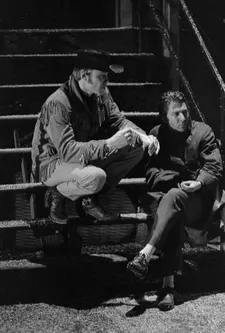 |
| Nancy Buirski: “Schlesinger is reminding you that every person is saveable, every person deserves our commitment and our care.” Photo: Michael Childers |
NB: No! I realised after it was all over that it was very much like having a conversation with someone. You know, how you free associate and you start talking - like we are right now! You begin to have a conversation and then you move from one thing to another and it happens organically. And I work with an editor who is wonderful; he and I worked together many times. He’s the kind of editor who can finish my thoughts. We’ll be in the edit together and we’d say: let’s talk about this! And we start creating that scene around that conversation we are having. And then that leads us to something else.
What I hoped would be that at the end it could all come together in a meaningful way. I was very concerned that if I had written it down, it would have been a lecture, and that’s not what I wanted. But something that was much more organic and exploratory. And I wanted the audience to make many of the connections themselves. Just the way you are right now.
In fact, using the word the Other is really telling, because this is also a film about the Other. Not just indigenous people in Vietnam or in America. But the Other is John Schlesinger himself, who was a gay man and felt very much the Other growing up in Great Britain. And then he comes to the United States and he is even more so, because he doesn’t even belong here. Who belongs where? And what gives you the right to tell that story? We talk about that question all the time.
AKT: And Dustin Hoffman saying in that interview that Ratso wasn’t that far removed from himself. He phrases it perfectly when he says it was “an interior feeling for me.” The Otherness is everywhere. I want to go back to the ending where we started for a moment. I noticed in the end credits a thanks to the genius Ann Roth.
Midnight Cowboy is also partly her creation. She is mentioned once by Brenda Vaccaro who says “Ann Roth saved my life” by putting her in the fur coat. I noticed again watching your film, how much Ann Roth does with the costumes. The white suit for Ratso! Which isn’t really a suit because the pants are more beige than the jacket and there’s the wine-red striped polo shirt. It’s all so intricate! A word about Ann Roth?
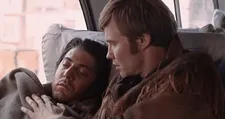 |
| Nancy Buirski: “John Schlesinger’s film is very much about compassion and about men bonding and caring for each other.” |
NB: I wish we had interviewed her. I mean, I spoke with her and we had a wonderful long conversation, but she wasn’t sure if she wanted to be interviewed. I mean, she loves Midnight Cowboy, and she’s proud of her work there, but she’s busy working on other things. She’s been around for a very long time and she’s still very active.
So she wasn’t really available and frankly, the film, even though we get into the making of Midnight Cowboy, the film is much more about the moment of Midnight Cowboy. I could have interviewed a number of other people who actually worked on the film but I needed to really save the time for these cultural and political conversations that we are having. I hope you didn’t miss Ann Roth too much. I would have loved to talk with her longer.
AKT: She’s great. I have been to her apartment some time ago and there was a birthday cake coming from Meryl Streep and we talked about many of her films. But she is so busy, doing all these wonderful things. Anyway, I wanted to give this shout out to Ann Roth.
NB: Thank you for doing that and please if you see her, tell her thank you from us!
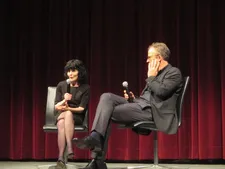 |
| Nancy Buirski with Tom McCarthy for her film By Sydney Lumet at the Museum of Modern Art in New York Photo: Anne-Katrin Titze |
AKT: I will if I do! I wish I would! A great moment in your film is when you go back to Look Back In Anger, A Taste Of Honey, and then The Sporting Life and I think it’s Richard Harris looking into the mirror?
NB: Yes it is.
AKT: Then we get the clip of Jon Voight looking into the mirror from Midnight Cowboy, and there’s Paul Newman as a cut-out on the side, and we hear the voice of Schlesinger. It’s the multi-dimensional references that are beautiful!
NB: Thank you! You know, we are dealing with the idea of masculinity. Dealing with what that means to be a man. And again Lucy Sante says at some point later in the film that there’s this kind of ambiguity around Jon Voight, because he’s got that pretty face. He’s got a childlike face.
And the whole question of the cowboy as a homoerotic object is connected to these other questions about masculinity. He’s standing in front of the mirror and making his muscles and all of that. So he wants to be thought of as very masculine but he does have this kind of very sweet and slightly feminine look to him. I think John Schlesinger knew that when he cast Jon Voight that he’s a pretty boy, right?
AKT: Yeah.
NB: These are all questions that come out in Midnight Cowboy. And we like to hint at these things. Again, the last thing I wanted to do is be didactic in our documentary, but I’m so glad you pick up on them, because those are, again, not accidental.
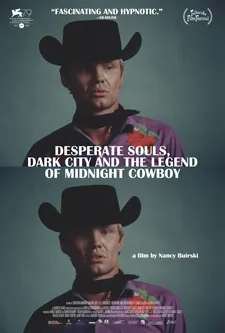 |
| Desperate Souls, Dark City And The Legend Of Midnight Cowboy poster |
AKT: That’s obvious, they couldn’t be. Even the split-second Walter Cronkite that flashes by to remind us of Kennedy and the entire history that comes with it. Of course the Oscars that year, talking of masculinity, were so interesting, with John Wayne receiving the award for best actor the same year Midnight Cowboy won best film. It’s so remarkable, you couldn’t write a script that way.
NB: I know, it is truer than fiction. I think there are a lot of layers that go along with that as well. I’ve just begun to think about not only did John Wayne represent old Hollywood and a kind of much more conventional masculine view of Hollywood and actors, because he considered Midnight Cowboy a gay movie and he didn’t like it.
So there is this irony of winning an Academy Award the same year that Midnight Cowboy wins an Academy Award. But I also found myself thinking about the fact that the Academy itself chose to honor John Wayne that year because he was ill. I’m not saying that’s the only reason he won, he was terrific in True Grit. But I couldn’t help wondering if they hadn’t taken a page from John Schlesinger’s playbook and been kind of compassionate about John Wayne who was dying.
AKT: That makes sense.
NB: We see at the end of our film Joe Buck taking care of Ratso. John Schlesinger’s film is very much about compassion and about men bonding and caring for each other. So John Wayne wins an Academy Award, who himself is dying. I may be making a leap there and going a little bit too far, but I couldn’t help wondering whether the message of Midnight Cowboy hadn’t come through to these Academy voters when they chose John Wayne.
AKT: Yes, and as you are talking, I am thinking of Joan Didion and her love for John Wayne because of that caring quality. Her longing for someone like John Wayne to build her a house “at the bend in the river where the cottonwoods grow.” That caring is Midnight Cowboy. “It’s about the need for human commitment,” someone says in your film. Not just momentary, but something that lasts.
 |
| Desperate Souls, Dark City And The Legend Of Midnight Cowboy screening at Film Forum in New York Photo: Anne-Katrin Titze |
NB: Yes. It’s really why I wanted to make this film. To embrace the idea that everybody is saveable. Everybody deserves love and care, that’s what comes through because these two characters, Ratso Rizzo and Joe Buck, on paper are not the most appealing characters. They become appealing because of these wonderful performances by Jon Voight and Dustin Hoffman. But we walk by those people every day and ignore them in life. And Schlesinger is reminding you that every person is saveable, every person deserves our commitment and our care. That’s really what drove me to make this documentary because I felt that was an important message in 2022, 2023.
AKT: Absolutely. It’s a beautiful film, thank you so much for this.
NB: You’re so welcome, it was wonderful to talk to you. We should have a coffee sometime!
AKT: Yes, we should! Let’s stay in touch!
NB: I’d love to continue the conversation, it was lovely! Take care!
Coming up - Nancy Buirski on Jon Voight, Jennifer Salt, and Sylvia Miles’s characters in Midnight Cowboy, John Schlesinger showing New York the way it really was, The Children’s Hour and Roberta Flack, and her longtime cinematographer Rex Miller.
Desperate Souls, Dark City And The Legend Of Midnight Cowboy is in cinemas in the US.






















